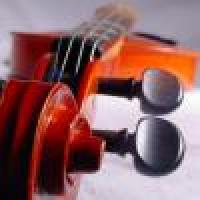
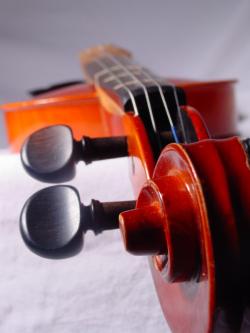
When you pluck a note on a guitar string, there isn't very much that can go wrong. You may not play the right note at the right time, of course, but a single note will always come out at the expected pitch, and sounding reasonably musical. When a beginner tries to play a violin, things are much more difficult. When a bow is drawn across a string, the result might be a musical note at the desired pitch, but on the other hand it might be an undesirable whistle, screech or graunch. This difference stems from a fundamental distinction between the physics of plucked and bowed strings.
Linear versus nonlinear: plucked versus bowed
A plucked string, like that on a guitar, can be described by linear systems theory. The essential feature of a linear system is that if you can find two different solutions to the governing equations, then the sum of the two is also a solution. In the context of vibration, this idea has a direct physical application.
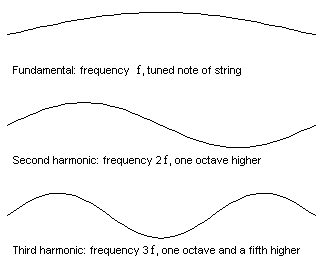
The first few vibration modes of a vibrating string...
A vibrating object like a stretched string has certain resonance frequencies, each associated with a particular pattern of vibration called a vibration mode. The corresponding resonance frequencies are the "fundamental" and "harmonics" of the note to which the string is tuned. If the string is set into vibration in the shape of one of these modes it will continue to vibrate in this shape at the corresponding resonance frequency, with an amplitude which gradually dies away as the energy is dissipated into sound and heat.

... and a string vibrating in all three modes at once
Now if the string is vibrated in a way that involves several of the mode shapes at once, then the principle of linearity comes into play. Each mode simply goes its own way, vibrating at its particular resonance frequency, and the total sound is the sum of the contributions from these separate modes (you can read more about adding harmonics in Music of the Primes in Issue 28). The guitar player can vary the mixture of amplitudes of the various modes, by plucking at different points on the string or using a different plectrum, but the set of resonance frequencies is always the same. In musical terms, the pitch of the note is always the same but the tonal quality can be adjusted. (To find out more about plucked strings and percussion instruments read the article What makes an object into a musical instrument?)
A bowed string is different. A note on a violin can be sustained for as long as your bow-stroke lasts, with a steady amplitude. Although energy is being dissipated into sound and heat, somehow the bow is supplying additional energy at exactly the right rate to compensate. This is one identifying sign of a non-linear system, for which the idea of adding contributions from different vibration modes cannot be applied in the simple way described above. The theory of such systems is always more intricate, and there is scope for very complicated outcomes and chaotic behaviour (read more about chaos in Issue 26). The range of good and bad noises which can be made on a violin string are examples of these complicated outcomes. The same general comments apply equally well to other musical instrument capable of a sustained tone such as the woodwind and brass instruments.
The motion of a bowed string
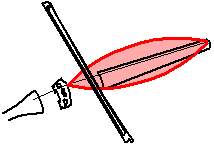
The string appears to vibrate in a parabola-like shape...
So how does a violin string vibrate? This question was first answered by Hermann von Helmholtz 140 years ago. When a violin is played in a normal way to produce a conventionally acceptable sound, the string can be seen to vibrate. To the naked eye, the string appears to move back and forth in a parabola-like shape, looking rather like the first mode of free vibration of a stretched elastic string.
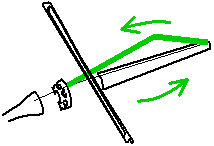
... but it actually moves in a V-shape.
However, upon closer inspection, Helmholtz observed that it moved in a very unexpected way: the string actually moves in a "V"-shape, i.e. the string gets divided into two straight portions which meet at a sharp corner. The fact that we see a gently curving (parabola-like) outline to the string's motion with the naked eye is because this sharp corner moves back and forth along this curve. Hence we only normally see the "envelope", or outline, of the motion of the string.
This motion, called Helmhotz motion is illustrated in this animation:
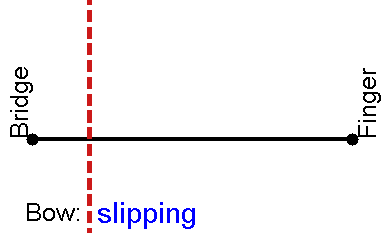
Helmholtz motion
The vertex of the V, called the Helmholtz corner, travels back and forth along the string. Each time this Helmholtz corner passes the bow, it triggers a transition between sticking and sliding friction: while the corner travels from bow to finger and back, the string sticks to the bow and is dragged along with it; then the string slips along the bow hairs (travelling in the opposite direction to the bow) while the corner travels to the bridge and back. The alternation between the two kinds of friction supplies the non-linear element to the system. (Find out how to observe the Helmholtz motion for yourself.)
If the violinist doesn't press hard enough with the bow, then instead of Helmholtz motion the string may move as shown here:
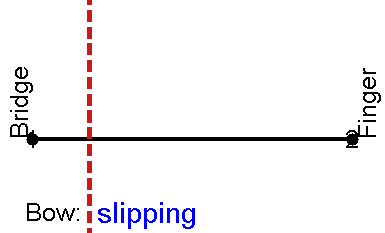
Double slipping motion
There are now two travelling corners on the string, and there are two episodes of slipping per cycle of the vibration. The result is a note at the same pitch as the Helmholtz motion, but with a different waveform and a different sound. For whatever historical reason, this sound is not regarded as acceptable, at least by Western classical violinists. Your violin teacher is likely to dismiss it as "surface sound", and tell you to practise more until you learn not to do it. The switch from Helmholtz motion to this double-slipping motion sets a minimum acceptable level to the bow force, the force with which the bow is pressed against the string.
There is also a maximum acceptable bow force. If the bow is pressed too hard, instead of a musical note the violin may produce a raucous "graunch" noise. The vibration of the string is no longer regular, but switches to a chaotic pattern. Needless to say, this sound is also disapproved of by violin teachers.
But bow force is not enough
The conditions for minimum and maximum bow force can tell us something interesting about the difficulty of playing the violin. When a simple analysis is done of these two conditions, it turns out that they both depend, among other things, on the position of the bow on the string. Suppose the length of the string is $L$, and that the bow is applied a distance $\beta L$ from the bridge, where $\beta$ is usually a rather small number for normal violin playing. Then it can be shown that the maximum bow force is proportional to $\beta^{-1}$, while the minimum bow force is proportional to $\beta^{-2}$. These two conditions can be combined in a graphical form first suggested by John Schelleng in the 1960s. It is most convenient to plot the bow force $N$ and the bow position $\beta$ on logarithmic scales, so that the two power-law relations become straight lines. The diagram then looks schematically like this:

The Schelleng diagram of bow force versus position for a long steady bow stroke
The shaded wedge shows the region within which Helmholtz motion can be achieved. Outside that region, the string does one or other of the undesirable things described above. It is immediately clear that it is easier to produce Helmholtz motion if the bow is away from the bridge: if the bow is too close to the bridge, the two force limits converge and it might not be possible to achieve Helmholtz motion at all.
But the picture reveals something else which is relevant to beginners on the violin. When you first try to play, you have many different things to think about: controlling the bow to touch the correct string, adjusting your left hand to finger the correct note, and so on. It can therefore happen that a beginner does not pay much attention to the position of the bow on the string, $\beta$. In other words, a beginner may move randomly along a more-or-less horizontal line in the Schelleng diagram. The shape of the Helmholtz region in the diagram immediately reveals that this could lead to falling below the minimum force line or rising above the maximum force line, even without the bow force being varied.
Playability
Of course, this is not the whole story about why the violin takes such a lot of practice in order to learn to play it well. The Schelleng diagram really only tells us about the possibility of obtaining Helmholtz motion during a long, steady bow-stroke.
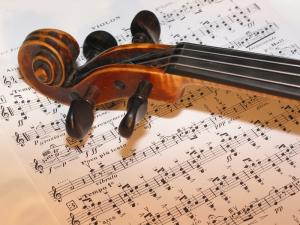
But will I get Helmholtz motion?
But violinists don't just want to play long, steady bow strokes. For musical purposes a wide variety of different bowing gestures are used, such as martelé (hammered bowing with a sudden release) and spiccato (rapid detached notes with the bow bouncing off the strings). A more advanced player will be interested in questions like "If I perform such-and-such a bow-stroke, will I get a Helmholtz motion? How long will it take to become established?". The second question is particularly important, because there is usually a transient period of non-regular motion of the string which may make the start of the note sound scratchy. A good bow gesture will minimise the length of this transient period, and establish Helmholtz motion quickly to give a crisp-sounding note.
This leads to the idea of playability of an instrument. Everyone knows that some violins are a great deal more valuable than others. Why does this happen, when all normal violins appear to be very similar? One aspect of this is "beauty of sound" from the instrument, which is very difficult to address in scientific terms because you first have to find out what a listener means by beautiful sound. However, if you watch a violinist trying out instruments, you may hear comments like "I don't really like the sound of this one, but it is very easy to play", or "This one sounds good but it is very slow to speak". Players are not only interested in sound quality, whatever that may mean precisely, but they are also interested in ease of playing - the playability of the instrument. If one violin is more accommodating than another, in terms of producing Helmholtz motion more reliably or faster, then that violin is likely to be preferred by a player.
Virtual violins
Unlike beauty of sound, this issue of playability lends itself to scientific investigation using mathematical models of a bowed violin string. Over the last 30 years increasingly sophisticated models have been developed. These models are too complicated to solve by pencil and paper mathematical methods, but they can be used to produce computer simulations of how a string on a particular violin will respond to a certain bow gesture. The models can explain a lot of the complicated things which a violin string can do, and they are beginning to be good enough to use to explore design questions: how could the design of a string, or bow, or violin body, be modified to improve the playability?
In a curiously circular way these theoretical models are also being used directly to make music. As computers have got faster it has become possible to run increasingly sophisticated simulation models in real time, to make "virtual musical instruments", where a mathematical model of an acoustic instrument is used as the basis of an electronic instrument (read more in our interview with an Audio software engineer in Issue 27). Some of the most expensive musical synthesiser systems use this approach, in what is called physical modelling synthesis.
Considering the complicated way in which a bowed violin string vibrates, it is not surprising that the violin is a difficult instrument to learn. There is a fine line between achieving Helmholtz motion and creating unacceptable surface and raucous sounds, whether you are just learning to play or are tackling the more advanced bowing techniques. But there is hope for those who have never learnt play the real thing: mathematical models of the physics of a bowed string may allow you to play a virtual violin after all.
About the authors
After a first degree in mathematics at Cambridge, Jim Woodhouse did a PhD on the acoustics of the violin, in the Department of Applied Mathematics and Theoretical Physics at Cambridge (this work being inspired by a hobby interest in building instruments). He then worked for an engineering consultancy firm for a few years, on a variety of problems in structural vibration, before joining the Engineering Department of the University (in 1985) as Lecturer, then later Reader and Professor. His research interests all involve vibration, and musical instruments have continued to form a major part.

Paul Galluzzo studied engineering as an undergraduate at Cambridge University, specializing in fluid dynamics. He is also a keen violinist, with vast experience performing in various countries. Pooling these engineering and musical backgrounds, he subsequently did a PhD on the acoustics of the violin at Cambridge University, specializing in the mechanics of bowed strings. He currently works for an engineering consultancy firm, in various fields involving mechanics and fluid dynamics, and is also involved with work in physiology and electrochemistry. He was recently elected to a Fellowship of Trinity College, Cambridge.